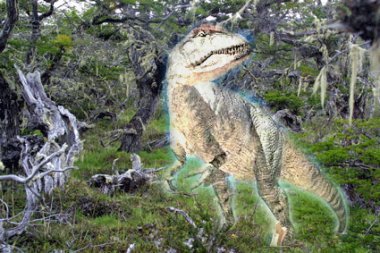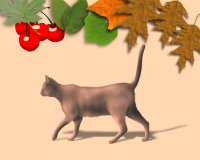Metsäinen Etelämanner
 Theropodi sub-antarktisessa metsässä
Theropodi sub-antarktisessa metsässäEtelämantereelta on löydetty noin 70 miljoonaa vuotta vanhojen dinosaurusten jäänteitä. Löydetyt dinot ovat sekä lihan- että kasvinsyöjiä. Ne ovat eläneet mantereella vielä silloin, kun dinosaurukset muualla ovat hiipuneet.
Dinosaurusten elinympäristö on ollut viileä, mutta metsäinen, tutkijat arvioivat. Fossiileista on aikaisemmin tunnisettu myös mosasauruksia, jotka elivät meressä. Dinosauruslöydöt todistavat, että Etelämanner on ollut lämmin ympäristö, vaikka manner on ollut suunnilleen nykyisellä paikallaan.
Etelämanner on taas lämpenemässä. Tohtori Robert Dunbar Stanfordin Yliopistosta on sanonut, että sadan vuoden kuluttua Etelämantereella saattaa kasvaa puita ja pensaita kuten 40 miljoonaa vuotta sitten. Läm,pötilan nousua on kummasteltu jo kolmenkymmenen vuoden ajan. Kasvihuoneilmiö ei selitä tätä paikallista lämpenemistä.
Dinosaurukset eivät palaa vaeltamaan uudesti syntyneissä metsissä (mikäli ennuste toteutuu), mutta pingviinit saavat ihmeteltävää. South Georgiaan on tuotu poroja - ehkä niitä voidaan viedä Etelämantereellekin?
After analysing the creature's lower body bones and teeth fossils, the researchers believed the animal had belonged to a population of dinosaurs that survived in Antarctica long after their kind had fallen by the evolutionary wayside elsewhere in the world.
"One of the surprising things is that animals with these more primitive characteristics generally haven't survived as long elsewhere as they have in Antarctica," said one of the researchers Professor Judd Case, from Saint Mary's College of California.
"But, for whatever reason, they were still hanging out on the Antarctic continent."
Dinosaurusten elinympäristö on ollut viileä, mutta metsäinen, tutkijat arvioivat. Fossiileista on aikaisemmin tunnisettu myös mosasauruksia, jotka elivät meressä. Dinosauruslöydöt todistavat, että Etelämanner on ollut lämmin ympäristö, vaikka manner on ollut suunnilleen nykyisellä paikallaan.
Martin [Dr. Jim Martin of the Museum of Geology in South Dakota] said the creatures probably came to Antarctica around 75 or 80 million years ago. The Antarctic climate at the time was ''probably subtropical in temperature.''
''This era is a perfect analogue for global warming,'' Martin said. ''It was much warmer worldwide then. That's the only way these reptiles could have swum around in the water. You don't see too many warm-blooded or semi-warm-blooded animals running round in the Antarctic.''
Etelämanner on taas lämpenemässä. Tohtori Robert Dunbar Stanfordin Yliopistosta on sanonut, että sadan vuoden kuluttua Etelämantereella saattaa kasvaa puita ja pensaita kuten 40 miljoonaa vuotta sitten. Läm,pötilan nousua on kummasteltu jo kolmenkymmenen vuoden ajan. Kasvihuoneilmiö ei selitä tätä paikallista lämpenemistä.
"That could point to some mechanism of climate change we don't understand, a failing in these models, or just a result of natural climate variability," said John Turner, a climate scientist with the British Antarctic Survey in Cambridge, England.
Dinosaurukset eivät palaa vaeltamaan uudesti syntyneissä metsissä (mikäli ennuste toteutuu), mutta pingviinit saavat ihmeteltävää. South Georgiaan on tuotu poroja - ehkä niitä voidaan viedä Etelämantereellekin?
 Mette miettii
Mette miettii












0 Comments:
Lähetä kommentti
<< Home